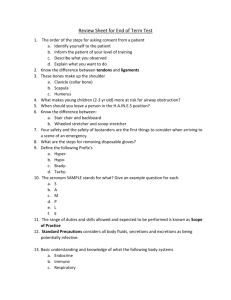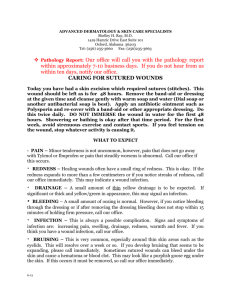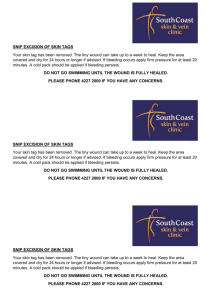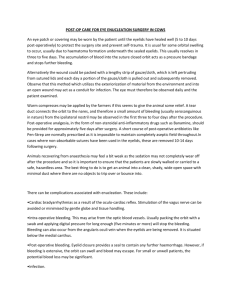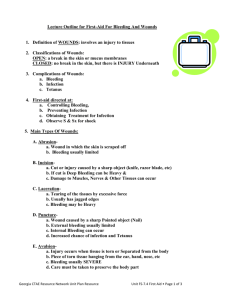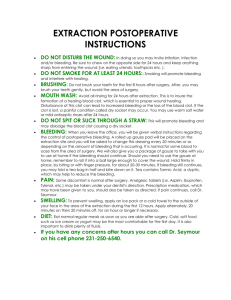CHAPTER 7: BLEEDING AND WOUNDS EXTERNAL BLEEDING
advertisement
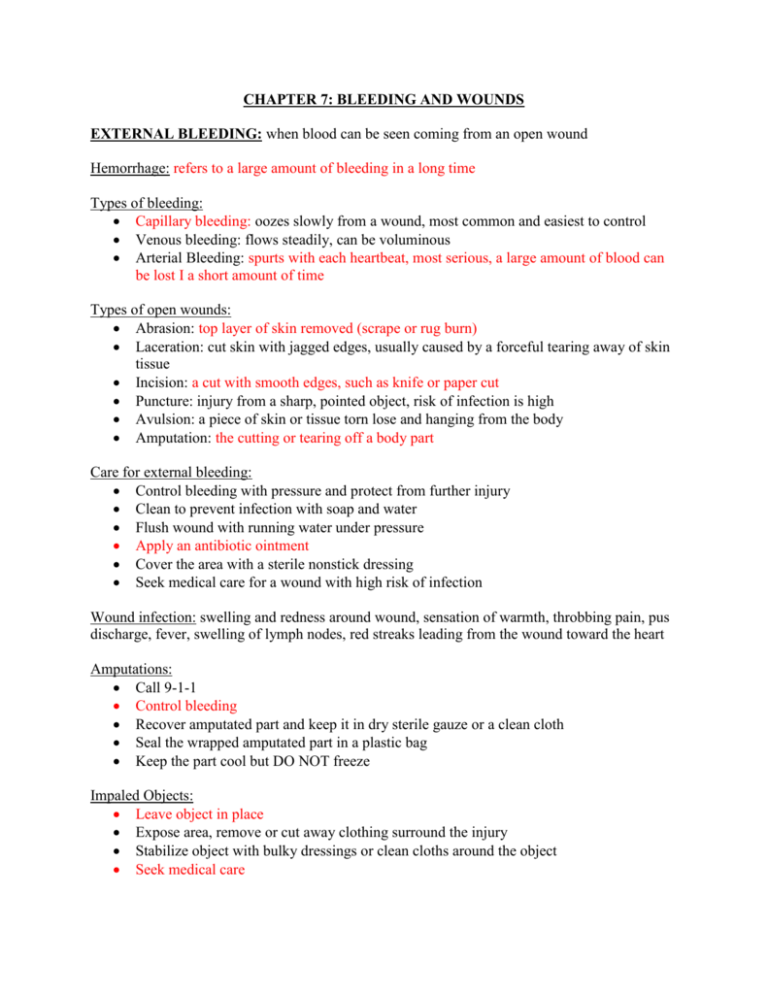
CHAPTER 7: BLEEDING AND WOUNDS EXTERNAL BLEEDING: when blood can be seen coming from an open wound Hemorrhage: refers to a large amount of bleeding in a long time Types of bleeding: Capillary bleeding: oozes slowly from a wound, most common and easiest to control Venous bleeding: flows steadily, can be voluminous Arterial Bleeding: spurts with each heartbeat, most serious, a large amount of blood can be lost I a short amount of time Types of open wounds: Abrasion: top layer of skin removed (scrape or rug burn) Laceration: cut skin with jagged edges, usually caused by a forceful tearing away of skin tissue Incision: a cut with smooth edges, such as knife or paper cut Puncture: injury from a sharp, pointed object, risk of infection is high Avulsion: a piece of skin or tissue torn lose and hanging from the body Amputation: the cutting or tearing off a body part Care for external bleeding: Control bleeding with pressure and protect from further injury Clean to prevent infection with soap and water Flush wound with running water under pressure Apply an antibiotic ointment Cover the area with a sterile nonstick dressing Seek medical care for a wound with high risk of infection Wound infection: swelling and redness around wound, sensation of warmth, throbbing pain, pus discharge, fever, swelling of lymph nodes, red streaks leading from the wound toward the heart Amputations: Call 9-1-1 Control bleeding Recover amputated part and keep it in dry sterile gauze or a clean cloth Seal the wrapped amputated part in a plastic bag Keep the part cool but DO NOT freeze Impaled Objects: Leave object in place Expose area, remove or cut away clothing surround the injury Stabilize object with bulky dressings or clean cloths around the object Seek medical care INTERNAL BLEEDING: a closed wound results when a blunt object does not break the skin, but tissue and blood vessel beneath the skin’s surface are crushed Recognizing internal bleeding: Bruising Painful, tender area Vomiting or coughing up blood Stool that is black or contains bright red blood Care for internal bleeding: o Apply ice or cold pack for 20 minutes o Compress the injured area by applying an elastic bandage for 2-3 hours o Elevate an injured arm or leg, if it is not broken o Repeat these steps o SERIOUS INTERNAL BLEEDING Call-9-11 Care for shock by placing victim on their back and covering them to maintain warmth If vomiting occurs, recovery position Monitor breathing DRESSING AND BANDAGES Dressing: a covering that is placed directly over a wound to absorb blood, prevent infections, and protect the wound from further injury (gauze pads, adhesive strips like bandaids) Bandage: such as a roll of gauze, often used to cover a dressing to keep in place on the wound and to apply pressure to control the bleeding CHAPTER 7: BLEEDING AND WOUNDS EXTERNAL BLEEDING: when blood can be seen coming from an open wound Hemorrhage: __________________________________________________________________ Types of bleeding: ___________________ oozes slowly from a wound, most common and easiest to control Venous bleeding: flows steadily, can be voluminous Arterial Bleeding: _________________________________________________________ ________________________________________________________________________ Types of open wounds: Abrasion: ______________________________________________ Laceration: cut skin with jagged edges, usually caused by a forceful tearing away of skin tissue Incision: ______________________________________________ Puncture: injury from a sharp, pointed object, risk of infection is high Avulsion: a piece of skin or tissue torn lose and hanging from the body Amputation: ______________________________________________ Care for external bleeding: Control bleeding with pressure and protect from further injury Clean to prevent infection with soap and water Flush wound with running water under pressure ______________________________________________ Cover the area with a sterile nonstick dressing Seek medical care for a wound with high risk of infection Wound infection: swelling and redness around wound, sensation of warmth, throbbing pain, pus discharge, fever, swelling of lymph nodes, red streaks leading from the wound toward the heart Amputations: Call 9-1-1 ______________________________________________ Recover amputated part and keep it in dry sterile gauze or a clean cloth Seal the wrapped amputated part in a plastic bag Keep the part cool but DO NOT freeze Impaled Objects: ______________________________________________ Expose area, remove or cut away clothing surround the injury Stabilize object with bulky dressings or clean cloths around the object ______________________________________________ INTERNAL BLEEDING: a closed wound results when a blunt object does not break the skin, but tissue and blood vessel beneath the skin’s surface are crushed Recognizing internal bleeding: ______________________________________________ ______________________________________________ Vomiting or coughing up blood Stool that is black or contains bright red blood Care for internal bleeding: o ______________________________________________ o Compress the injured area by applying an elastic bandage for 2-3 hours o ______________________________________________ o Repeat these steps o SERIOUS INTERNAL BLEEDING ______________________________________________ Care for shock by placing victim on their back and covering them to maintain warmth If vomiting occurs, recovery position Monitor breathing DRESSING AND BANDAGES Dressing: _____________________________________________________________________ ______________________________________________________________________________ Bandage: such as a roll of gauze, often used to cover a dressing to keep in place on the wound and to apply pressure to control the bleeding
